[English] 日本語
 Yorodumi
Yorodumi- PDB-7d68: Cryo-EM structure of the human glucagon-like peptide-2 receptor-G... -
+ Open data
Open data
- Basic information
Basic information
| Entry | Database: PDB / ID: 7d68 | ||||||
|---|---|---|---|---|---|---|---|
| Title | Cryo-EM structure of the human glucagon-like peptide-2 receptor-Gs protein complex | ||||||
 Components Components |
| ||||||
 Keywords Keywords | BIOSYNTHETIC PROTEIN / Glucagon-like peptide-2 receptor / Drug target / Class B GPCR | ||||||
| Function / homology |  Function and homology information Function and homology informationglucagon receptor binding / Olfactory Signaling Pathway / Sensory perception of sweet, bitter, and umami (glutamate) taste / Synthesis, secretion, and inactivation of Glucagon-like Peptide-1 (GLP-1) / glucagon receptor activity / sensory perception of chemical stimulus / Activation of the phototransduction cascade / negative regulation of execution phase of apoptosis / G protein-coupled peptide receptor activity / feeding behavior ...glucagon receptor binding / Olfactory Signaling Pathway / Sensory perception of sweet, bitter, and umami (glutamate) taste / Synthesis, secretion, and inactivation of Glucagon-like Peptide-1 (GLP-1) / glucagon receptor activity / sensory perception of chemical stimulus / Activation of the phototransduction cascade / negative regulation of execution phase of apoptosis / G protein-coupled peptide receptor activity / feeding behavior / Activation of G protein gated Potassium channels / G-protein activation / G beta:gamma signalling through PI3Kgamma / Prostacyclin signalling through prostacyclin receptor / G beta:gamma signalling through PLC beta / ADP signalling through P2Y purinoceptor 1 / Thromboxane signalling through TP receptor / Presynaptic function of Kainate receptors / G beta:gamma signalling through CDC42 / Inhibition of voltage gated Ca2+ channels via Gbeta/gamma subunits / Glucagon-type ligand receptors / Adrenaline,noradrenaline inhibits insulin secretion / G alpha (12/13) signalling events / G beta:gamma signalling through BTK / ADP signalling through P2Y purinoceptor 12 / Cooperation of PDCL (PhLP1) and TRiC/CCT in G-protein beta folding / Thrombin signalling through proteinase activated receptors (PARs) / Ca2+ pathway / G alpha (z) signalling events / Extra-nuclear estrogen signaling / G alpha (s) signalling events / G alpha (q) signalling events / G alpha (i) signalling events / Glucagon-like Peptide-1 (GLP1) regulates insulin secretion / Vasopressin regulates renal water homeostasis via Aquaporins / positive regulation of calcium ion import / cellular response to glucagon stimulus / response to starvation / positive regulation of insulin secretion involved in cellular response to glucose stimulus / peptide hormone binding / regulation of insulin secretion / mu-type opioid receptor binding / corticotropin-releasing hormone receptor 1 binding / D1 dopamine receptor binding / Synthesis, secretion, and deacylation of Ghrelin / beta-2 adrenergic receptor binding / adenylate cyclase-activating adrenergic receptor signaling pathway / positive regulation of gluconeogenesis / negative regulation of inflammatory response to antigenic stimulus / protein kinase A signaling / adenylate cyclase activator activity / positive regulation of peptidyl-threonine phosphorylation / response to activity / gluconeogenesis / G protein-coupled receptor activity / ionotropic glutamate receptor binding / insulin-like growth factor receptor binding / G-protein beta/gamma-subunit complex binding / adenylate cyclase-modulating G protein-coupled receptor signaling pathway / adenylate cyclase-activating G protein-coupled receptor signaling pathway / hormone activity / Glucagon signaling in metabolic regulation / Synthesis, secretion, and inactivation of Glucagon-like Peptide-1 (GLP-1) / photoreceptor disc membrane / Glucagon-type ligand receptors / cellular response to catecholamine stimulus / Glucagon-like Peptide-1 (GLP1) regulates insulin secretion / ADORA2B mediated anti-inflammatory cytokines production / adenylate cyclase-activating dopamine receptor signaling pathway / cellular response to prostaglandin E stimulus / G-protein beta-subunit binding / heterotrimeric G-protein complex / signaling receptor complex adaptor activity / positive regulation of peptidyl-serine phosphorylation / glucose homeostasis / G alpha (s) signalling events / G alpha (q) signalling events / secretory granule lumen / membrane => GO:0016020 / cell surface receptor signaling pathway / positive regulation of ERK1 and ERK2 cascade / G protein-coupled receptor signaling pathway / endoplasmic reticulum lumen / signaling receptor binding / GTPase activity / positive regulation of cell population proliferation / GTP binding / negative regulation of apoptotic process / extracellular space / extracellular region / identical protein binding / membrane / metal ion binding / plasma membrane / cytoplasm Similarity search - Function | ||||||
| Biological species |   Homo sapiens (human) Homo sapiens (human)synthetic construct (others) | ||||||
| Method | ELECTRON MICROSCOPY / single particle reconstruction / cryo EM / Resolution: 3 Å | ||||||
 Authors Authors | Sun, W. / Chen, L. / Zhou, Q. / Zhao, L. / Zhang, H. / Cong, Z. / Shen, D. / Zhao, F. / Zhou, F. / Cai, X. ...Sun, W. / Chen, L. / Zhou, Q. / Zhao, L. / Zhang, H. / Cong, Z. / Shen, D. / Zhao, F. / Zhou, F. / Cai, X. / Chen, Y. / Zhou, Y. / Gadgaard, S. / van der Velden, W.J. / Zhao, S. / Jiang, Y. / Rosenkilde, M.M. / Yang, D. / Xu, H.E. / Zhang, Y. / Wang, M. | ||||||
 Citation Citation |  Journal: Cell Res / Year: 2020 Journal: Cell Res / Year: 2020Title: A unique hormonal recognition feature of the human glucagon-like peptide-2 receptor. Authors: Wen Sun / Li-Nan Chen / Qingtong Zhou / Li-Hua Zhao / Dehua Yang / Huibing Zhang / Zhaotong Cong / Dan-Dan Shen / Fenghui Zhao / Fulai Zhou / Xiaoqing Cai / Yan Chen / Yan Zhou / Sarina ...Authors: Wen Sun / Li-Nan Chen / Qingtong Zhou / Li-Hua Zhao / Dehua Yang / Huibing Zhang / Zhaotong Cong / Dan-Dan Shen / Fenghui Zhao / Fulai Zhou / Xiaoqing Cai / Yan Chen / Yan Zhou / Sarina Gadgaard / Wijnand J C van der Velden / Suwen Zhao / Yi Jiang / Mette M Rosenkilde / H Eric Xu / Yan Zhang / Ming-Wei Wang /   Abstract: Glucagon-like peptides (GLP-1 and GLP-2) are two proglucagon-derived intestinal hormones that mediate distinct physiological functions through two related receptors (GLP-1R and GLP-2R) which are ...Glucagon-like peptides (GLP-1 and GLP-2) are two proglucagon-derived intestinal hormones that mediate distinct physiological functions through two related receptors (GLP-1R and GLP-2R) which are important drug targets for metabolic disorders and Crohn's disease, respectively. Despite great progress in GLP-1R structure determination, our understanding on the differences of peptide binding and signal transduction between these two receptors remains elusive. Here we report the electron microscopy structure of the human GLP-2R in complex with GLP-2 and a G heterotrimer. To accommodate GLP-2 rather than GLP-1, GLP-2R fine-tunes the conformations of the extracellular parts of transmembrane helices (TMs) 1, 5, 7 and extracellular loop 1 (ECL1). In contrast to GLP-1, the N-terminal histidine of GLP-2 penetrates into the receptor core with a unique orientation. The middle region of GLP-2 engages with TM1 and TM7 more extensively than with ECL2, and the GLP-2 C-terminus closely attaches to ECL1, which is the most protruded among 9 class B G protein-coupled receptors (GPCRs). Functional studies revealed that the above three segments of GLP-2 are essential for GLP-2 recognition and receptor activation, especially the middle region. These results provide new insights into the molecular basis of ligand specificity in class B GPCRs and may facilitate the development of more specific therapeutics. | ||||||
| History |
|
- Structure visualization
Structure visualization
| Movie |
 Movie viewer Movie viewer |
|---|---|
| Structure viewer | Molecule:  Molmil Molmil Jmol/JSmol Jmol/JSmol |
- Downloads & links
Downloads & links
- Download
Download
| PDBx/mmCIF format |  7d68.cif.gz 7d68.cif.gz | 209.3 KB | Display |  PDBx/mmCIF format PDBx/mmCIF format |
|---|---|---|---|---|
| PDB format |  pdb7d68.ent.gz pdb7d68.ent.gz | 164 KB | Display |  PDB format PDB format |
| PDBx/mmJSON format |  7d68.json.gz 7d68.json.gz | Tree view |  PDBx/mmJSON format PDBx/mmJSON format | |
| Others |  Other downloads Other downloads |
-Validation report
| Summary document |  7d68_validation.pdf.gz 7d68_validation.pdf.gz | 738.5 KB | Display |  wwPDB validaton report wwPDB validaton report |
|---|---|---|---|---|
| Full document |  7d68_full_validation.pdf.gz 7d68_full_validation.pdf.gz | 749.2 KB | Display | |
| Data in XML |  7d68_validation.xml.gz 7d68_validation.xml.gz | 33.9 KB | Display | |
| Data in CIF |  7d68_validation.cif.gz 7d68_validation.cif.gz | 50.8 KB | Display | |
| Arichive directory |  https://data.pdbj.org/pub/pdb/validation_reports/d6/7d68 https://data.pdbj.org/pub/pdb/validation_reports/d6/7d68 ftp://data.pdbj.org/pub/pdb/validation_reports/d6/7d68 ftp://data.pdbj.org/pub/pdb/validation_reports/d6/7d68 | HTTPS FTP |
-Related structure data
| Related structure data |  30590MC M: map data used to model this data C: citing same article ( |
|---|---|
| Similar structure data |
- Links
Links
- Assembly
Assembly
| Deposited unit | 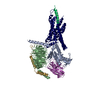
|
|---|---|
| 1 |
|
- Components
Components
-Guanine nucleotide-binding protein ... , 3 types, 3 molecules ABG
| #1: Protein | Mass: 43897.789 Da / Num. of mol.: 1 / Mutation: G226A, A366S Source method: isolated from a genetically manipulated source Source: (gene. exp.)   |
|---|---|
| #2: Protein | Mass: 40226.992 Da / Num. of mol.: 1 Source method: isolated from a genetically manipulated source Source: (gene. exp.)   |
| #3: Protein | Mass: 7861.143 Da / Num. of mol.: 1 Source method: isolated from a genetically manipulated source Source: (gene. exp.)   |
-Antibody / Protein/peptide / Protein / Non-polymers , 4 types, 10 molecules NPR

| #4: Antibody | Mass: 13711.284 Da / Num. of mol.: 1 / Source method: obtained synthetically / Source: (synth.) synthetic construct (others) |
|---|---|
| #5: Protein/peptide | Mass: 3769.136 Da / Num. of mol.: 1 Source method: isolated from a genetically manipulated source Source: (gene. exp.)  Homo sapiens (human) / Gene: GCG / Production host: Homo sapiens (human) / Gene: GCG / Production host:  |
| #6: Protein | Mass: 75534.836 Da / Num. of mol.: 1 Source method: isolated from a genetically manipulated source Source: (gene. exp.)  Homo sapiens (human) / Gene: GLP2R / Production host: Homo sapiens (human) / Gene: GLP2R / Production host:  |
| #7: Water | ChemComp-HOH / |
-Experimental details
-Experiment
| Experiment | Method: ELECTRON MICROSCOPY |
|---|---|
| EM experiment | Aggregation state: PARTICLE / 3D reconstruction method: single particle reconstruction |
- Sample preparation
Sample preparation
| Component |
| ||||||||||||||||||||||||||||||
|---|---|---|---|---|---|---|---|---|---|---|---|---|---|---|---|---|---|---|---|---|---|---|---|---|---|---|---|---|---|---|---|
| Molecular weight | Units: MEGADALTONS / Experimental value: YES | ||||||||||||||||||||||||||||||
| Source (natural) |
| ||||||||||||||||||||||||||||||
| Source (recombinant) |
| ||||||||||||||||||||||||||||||
| Buffer solution | pH: 7.4 | ||||||||||||||||||||||||||||||
| Specimen | Embedding applied: NO / Shadowing applied: NO / Staining applied: NO / Vitrification applied: YES | ||||||||||||||||||||||||||||||
| Vitrification | Cryogen name: ETHANE |
- Electron microscopy imaging
Electron microscopy imaging
| Experimental equipment |  Model: Titan Krios / Image courtesy: FEI Company |
|---|---|
| Microscopy | Model: FEI TITAN KRIOS |
| Electron gun | Electron source:  FIELD EMISSION GUN / Accelerating voltage: 300 kV / Illumination mode: FLOOD BEAM FIELD EMISSION GUN / Accelerating voltage: 300 kV / Illumination mode: FLOOD BEAM |
| Electron lens | Mode: BRIGHT FIELD |
| Image recording | Electron dose: 64 e/Å2 / Detector mode: COUNTING / Film or detector model: GATAN K2 QUANTUM (4k x 4k) |
- Processing
Processing
| Software | Name: PHENIX / Version: 1.16_3549: / Classification: refinement | ||||||||||||||||||||||||
|---|---|---|---|---|---|---|---|---|---|---|---|---|---|---|---|---|---|---|---|---|---|---|---|---|---|
| CTF correction | Type: PHASE FLIPPING AND AMPLITUDE CORRECTION | ||||||||||||||||||||||||
| 3D reconstruction | Resolution: 3 Å / Resolution method: FSC 0.143 CUT-OFF / Num. of particles: 284669 / Symmetry type: POINT | ||||||||||||||||||||||||
| Refine LS restraints |
|
 Movie
Movie Controller
Controller


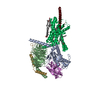


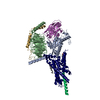

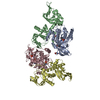
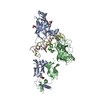

 PDBj
PDBj



















